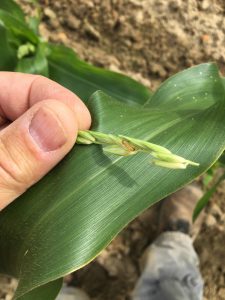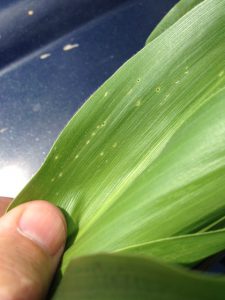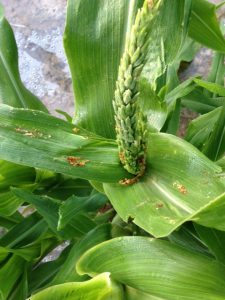Rutgers NJAES Wine Grape Extension, in association with Penn State Extension Grape and Wine Team, is calling on those who own, operate, or manage a farm or vineyard in the New Jersey region to participate in a survey that aims to track the spread and severity of nymph and adult spotted lanternfly populations during the 2023 season. The data collected will provide insights into the distribution patterns of both nymph and adult SLF within and outside vineyards, enabling growers and researchers to better understand this invasive pest’s potential impact on agriculture in the Mid-Atlantic region. [Read more…]
Vegetable Crops Edition
Seasonal updates and alerts on insects, diseases, and weeds impacting vegetable crops. New Jersey Commercial Vegetable Production Recommendations updates between annual publication issues are included.
Subscriptions are available via EMAIL and RSS.
Quick Links:
 NJ Commercial Vegetable Production Recommendations
NJ Commercial Vegetable Production Recommendations
 Rutgers Weather Forecasting - Meteorological Information important to commercial agriculture.
Rutgers Weather Forecasting - Meteorological Information important to commercial agriculture.
Vegetable IPM Update 6/07/23
Sweet Corn
Warmer evening temperatures have resulted in modest increases in European corn borer (ECB) moth catches in blacklight traps in the northern and central counties. Whorl corn is the primary target for egg laying, and injury over the 12% threshold has been found in Hunterdon County this week. It is likely that there are pockets of feeding throughout the southern counties. Despite relatively low numbers, this pest still poses a threat to plantings now approaching full tassel. It is typical for feeding percentages to rise as the moth catch declines. We expect feeding to increase for the next 1-2 weeks before peaking.
 Look for the characteristic “shot-hole” type of feeding (photo below at right) and consider treating when infested plants exceed 12% in a 50 plant sample. As plantings proceed to the pre-tassel stage, ECB larvae may be found in emerging tassels (see photo at left). It is a good idea to treat individual plantings as they move into the full tassel/first silk stage one time. This eliminates any ECB larvae that have emerged with the tassels as they begin to move down the stalk to re-enter near developing ears.
Look for the characteristic “shot-hole” type of feeding (photo below at right) and consider treating when infested plants exceed 12% in a 50 plant sample. As plantings proceed to the pre-tassel stage, ECB larvae may be found in emerging tassels (see photo at left). It is a good idea to treat individual plantings as they move into the full tassel/first silk stage one time. This eliminates any ECB larvae that have emerged with the tassels as they begin to move down the stalk to re-enter near developing ears.
Useful insecticides for this particular application include synthetic  pyrethroids (IRAC Grp 3), spinosyns (including OMRI approved Entrust) IRAC Grp 5), and diamides such as Coragen or Vantacor (IRAC Grp 28) or materials such as Besiege which include the active ingredient in Coragen. Synthetic pyrethroids alone should NOT be used for corn earworm (CEW) protection on silking corn. Control with these materials is very inconsistent.
pyrethroids (IRAC Grp 3), spinosyns (including OMRI approved Entrust) IRAC Grp 5), and diamides such as Coragen or Vantacor (IRAC Grp 28) or materials such as Besiege which include the active ingredient in Coragen. Synthetic pyrethroids alone should NOT be used for corn earworm (CEW) protection on silking corn. Control with these materials is very inconsistent.
The highest nightly trap catches of ECB for the week ending 6/07/23 are as follows:
| Sergeantsville 2 | Oldwick 1 |
| Asbury 1 | Port Murray 1 |
| Hillsborough 1 | South Branch 1 |
Vegetable IPM Update 5/30/23
Sweet Corn
Due to continued cold night temperatures, European corn borer (ECB) moth captures have been extremely low in northern and central county light traps. Thus far this flight has been weak, and no feeding has been detected on whorl and pre-tassel stage sweet corn as far south as northern Burlington County. An increase in nighttime temperatures (even temporarily) may result in somewhat higher numbers over the next week. Whorl corn is the primary target for egg laying. If the first flight is late rather than nonexistent, this sometimes results in heavier infestations on 2nd and 3rd plantings than on the first. Feeding levels could be somewhat higher in the southern counties, and should rise over the next 3 weeks.
 Look for the characteristic “shot-hole” type of feeding (photo below at right) and consider treating when infested plants exceed 12% in a 50 plant sample. As plantings proceed to the pre-tassel stage, ECB larvae may be found in emerging tassels (see photo at left). It is a good idea to treat individual plantings as they move into the full tassel/first silk stage one time. This eliminates any ECB larvae that have emerged with the tassels as they begin to move down the stalk to re-enter near developing ears.
Look for the characteristic “shot-hole” type of feeding (photo below at right) and consider treating when infested plants exceed 12% in a 50 plant sample. As plantings proceed to the pre-tassel stage, ECB larvae may be found in emerging tassels (see photo at left). It is a good idea to treat individual plantings as they move into the full tassel/first silk stage one time. This eliminates any ECB larvae that have emerged with the tassels as they begin to move down the stalk to re-enter near developing ears.
Useful insecticides for this particular application include synthetic  pyrethroids (IRAC Grp 3), spinosyns (including OMRI approved Entrust) IRAC Grp 5), and diamides such as Coragen or Vantacor (IRAC Grp 28) or materials such as Besiege which include the active ingredient in Coragen. Synthetic pyrethroids alone should NOT be used for corn earworm (CEW) protection on silking corn. Control with these materials is very inconsistent.
pyrethroids (IRAC Grp 3), spinosyns (including OMRI approved Entrust) IRAC Grp 5), and diamides such as Coragen or Vantacor (IRAC Grp 28) or materials such as Besiege which include the active ingredient in Coragen. Synthetic pyrethroids alone should NOT be used for corn earworm (CEW) protection on silking corn. Control with these materials is very inconsistent.
The highest nightly trap catches of ECB for the week ending 5/30/23 are as follows:
| Blairstown 1 | Princeton 1 |
| Chester 1 | Sergeantsville 1 |
| Morristown 1 | South Branch 1 |
Vegetable IPM Update 5/24/23
Sweet Corn
Scattered European corn borer (ECB) moths are now being captured in central and northern counties, and this insect is certainly active in southern parts of the state. Numbers are quite low. It remains to be seen whether this first flight will amount to much, but recent years’ catches give no reason to suspect that a large population will develop. Whorl corn is the primary target for egg laying, but as yet, scouts have reported no signs of feeding injury. In northern and central counties, corn plantings that were started on/under plastic are now reaching a size that will support ECB larvae. We expect to encounter some level of feeding over the next 2 weeks, although the majority of plantings have not required insecticide treatments for ECB prior to full tassel in the past several years.
 Look for the characteristic “shot-hole” type of feeding (photo below at right) and consider treating when infested plants exceed 12% in a 50 plant sample. As plantings proceed to the pre-tassel stage, ECB larvae may be found in emerging tassels (see photo at left). It is a good idea to treat individual plantings as they move into the full tassel/first silk stage one time. This eliminates any ECB larvae that have emerged with the tassels as they begin to move down the stalk to re-enter near developing ears.
Look for the characteristic “shot-hole” type of feeding (photo below at right) and consider treating when infested plants exceed 12% in a 50 plant sample. As plantings proceed to the pre-tassel stage, ECB larvae may be found in emerging tassels (see photo at left). It is a good idea to treat individual plantings as they move into the full tassel/first silk stage one time. This eliminates any ECB larvae that have emerged with the tassels as they begin to move down the stalk to re-enter near developing ears.
Useful insecticides for this particular application include synthetic  pyrethroids (IRAC Grp 3), spinosyns (including OMRI approved Entrust) IRAC Grp 5), and diamides such as Coragen or Vantacor (IRAC Grp 28) or materials such as Besiege which include the active ingredient in Coragen. Synthetic pyrethroids alone should NOT be used for corn earworm (CEW) protection on silking corn. Control with these materials is very inconsistent.
pyrethroids (IRAC Grp 3), spinosyns (including OMRI approved Entrust) IRAC Grp 5), and diamides such as Coragen or Vantacor (IRAC Grp 28) or materials such as Besiege which include the active ingredient in Coragen. Synthetic pyrethroids alone should NOT be used for corn earworm (CEW) protection on silking corn. Control with these materials is very inconsistent.
The highest nightly trap catches* of ECB for the week ending 5/24/23 are as follows:
| Asbury 1 | Matawan 1 |
| Chester 1 | New Egypt 1 |
| Denville 1 | Old Bridge 1 |
| Long Valley 1 | Oldwick 1 |
* No blacklight traps are in operation south of the Columbus (Burlington Co.) area this season.
United States Department of Agriculture (USDA) Changes to Audit Costs
USDA has just announced that proposed audit fees for the Harmonized and GAP/GHP audits will increase to $155 per hour. The average Harmonized Audit runs anywhere from 12 to 15 hours, GAP/GHP audits average 5 to 10 hours. The current fee is $132 per hour. For anyone who needs an audit try to schedule before October 1, 2023 when the new rates take effect. For further information or discuss the proposed increases contact: Melissa Bailey, Associate Administrator, AMS, USDA, Room 2036–S, 1400 Independence Ave. SW, Washington, DC 20250; telephone (202) 205–9356, or email melissa.bailey@usda.gov.
South Jersey Tree Fruit Twilight Meeting – II
May 31st @ 5 – 7 pm Summit City Orchards: 500 University Blvd. Glassboro, NJ 08028 Pesticide credits applied Category: 1A, PP2, 10 4:45 pm Gather at the Parking lot of the Summit City Winery (above address) 5:00 pm Peach Fruit Thinning - Physiology and Methods Daniel Ward, Extension Specialist, Pomology, Rutgers NJAES. Demonstration of the Peach Fruit Thinning Using the Machine Richard Bannister and Eli Bannister, Richard’s Station. Field Observations from the IPM Program Dave Schmitt, Fruit IPM Program Associate, Rutgers NJAES Summer Disease Control Measures in Orchards Norman Lalancette, Extension Specialist, Tree Fruit Pathology, Rutgers NJAES 7:00 pm Pesticide re-certification credits application and Adjourn Light fare will be provided. Please call Joan Medany jmedany@co.gloucester.nj.us or call 856-224-8030 if you are planning to attend. If an additional assistance is needed, please contact Hemant Gohil at 856-224-8029 prior to the meeting.
